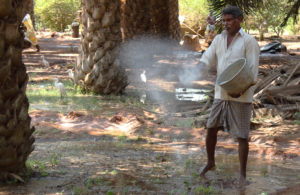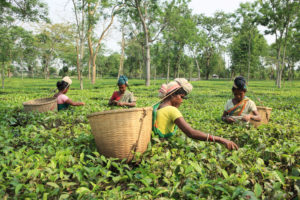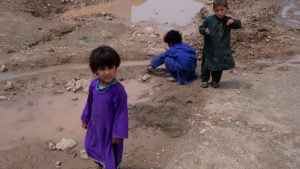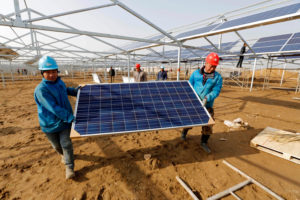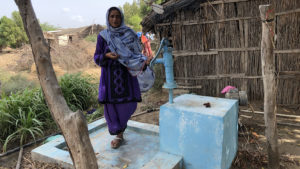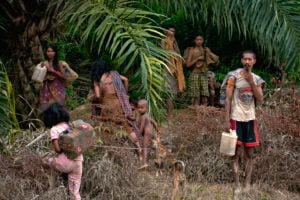Mature palms flank the winding dirt track leading to Tallavalli village. A. Chandrasekar Rao has made his homestead here in the Krishna district of Andhra Pradesh, on a four-hectare oil palm farm. He is happy about his decision to switch from farming mangoes in 1996. His income has tripled as a result.
In neighbouring West Godavari district, maize, rice and oil palm fields vie for space. Balusu Bala Chandrasekar of Mundur village says his oil palm farm helped him educate both his sons as engineers, and to build a house.
In the southern Indian state of Andhra Pradesh, oil palm farmers are pleased with their crop. They earn more and do not have to deal with middlemen to sell their produce. Millers buy the oil palm fruit bunches directly, and pay within two weeks.
Oil palm is touted as a win-win for farmers, the palm oil industry and government. But the economic prosperity appears to be coming at a critical cost: water.
Oil palm in Andhra Pradesh
India has been importing palm oil since the 1960s, at a cost of USD 5 billion per year. With increasing demand representing a drain on foreign exchange, the Indian government has been resolutely promoting domestic oil palm cultivation since the 1990s.
It plans to expand palm oil plantations across the country from the current 0.35 million hectares (Mha) to 1.93 Mha.
Andhra Pradesh has the largest identified potential area for oil palm expansion with 0.42 Mha, according to the government’s latest agricultural data.
The state has already seen massive growth in oil palm cultivation. The earliest available data shows that in 1993 oil palm was grown in three provinces. Kerala produced the highest yield of fresh fruit bunches, at 14,051 tonnes, with Andhra Pradesh a long way behind with 58 tonnes. Andhra Pradesh picked up quickly and in 2007-08 it had the highest yield in the country, with 194,000 tonnes. This was attributed to the provincial government’s promotion of the crop.
Today, Andhra Pradesh has the highest amount of land under oil palm cultivation of all states, with 0.17 Mha, as well as yield – 1.38 million tonnes of fresh fruit bunches.
Golden crop?
For many farmers, crop failures were common until the 1990s because of water scarcity, pest attacks and extreme weather events. Following the government’s promotion and financial incentives, some of them tried oil palm on part of their lands. The plants fared well, and others soon followed the pioneers.
In West Godavari district, former air force officer E.V. Subba Rao switched to oil palm when he saw middlemen reaping the benefits of his labour from his bamboo and cashew plantations. Such middlemen habitually indebt farmers, underpay for produce and make large profits when selling on. With oil palm, Subba Rao’s contact is a single miller, who buys the crop directly from him.
Farmers find oil palm gives them higher income and lower labour needs than paddy, sugarcane, maize, tobacco and horticultural crops. It is also less prone to damage during extreme weather events.
Except for the recent whitefly attacks, they hardly have any pest problems. Those attacks were serious, however, damaging around 11,000 hectares of crops. Nagabushnam Rao in Krishna district said the problem started in West and East Godavari districts two years ago, and spread to his area a few months ago. The flies reduce yield by 30-40%, according to Chandrasekar Rao.
Still, oil palm remains a favourite.
Before switching to oil palms, Balusu Bala Chandrasekar suffered heavy losses when his banana plants were flattened by a cyclone. Many find oil palm hardy and better able to withstand extreme weather events.
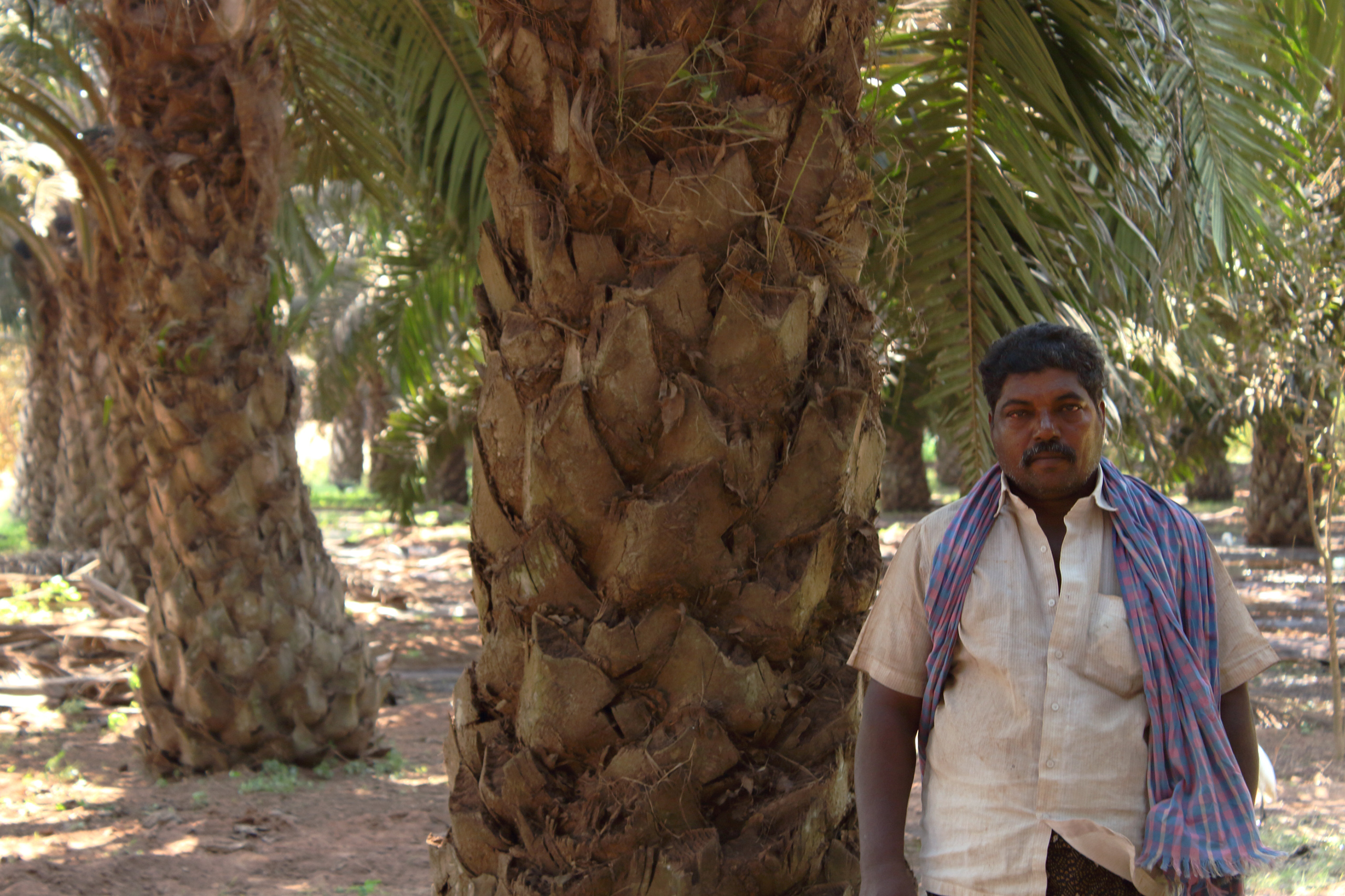
K. Prasad of West Godavari was encouraged by the crop’s longevity, and planted oil palm on his four-hectare farm. He leased extra land to grow maize and banana. Murthy Pendyala of East Godavari and L. Pradeep of West Godavari have also been impressed by the crop’s success, and have increased their oil palm acreage. “Oil palm is a golden crop for farmers,” said K. Nagabushnam Rao in Krishna district.
Resource-intensive
Some officials of district horticulture departments disagree. They say oil palm is not a sustainable crop and point out its failure in Nellore and Anantapur districts. Though the department’s portal lists the areas in these districts where oil palm is grown as 4,169 ha and 282 ha respectively, officials say that information is outdated.
“Now we have 850 hectares only. About five years ago, many farmers removed the trees because of water scarcity,” said SMA Khaleem, assistant director of horticulture for Nellore district.
“Presently, oil palm cultivation in our district is nil,” said P. Padmalatha, deputy director of horticulture in Anantapur district. “Now no one in my district grows it, since it needs more water.”
Oil palm cultivation in our district is nil. No one in my district grows it, since it needs more water.P. Padmalatha, deputy director of horticulture in Anantapur district
“Oil palm is a water- and nutrient-loving crop,” said R.K. Mathur, director of the Indian Institute of Oil Palm Research (IIOPR). “Though a rain-fed crop in other countries, we have successfully established that it can be grown under irrigation, requiring 240 to 300 litres per palm per day (lpd), rising to 325 to 350 lpd in summer.”
Rainfall variability
The National Mission on Oilseeds and Oil Palm (NMOOP) states the crop requires evenly distributed annual rainfall of 2,500-4,000 mm. However, the maximum rainfall of India’s coastal districts ranges from 1,045-1,170 mm, according to an analysis of rainfall variability data over 30 years by the India Meteorological Department.
The department found high rainfall variability over time and space. Climate change appears to have caused significant changes to rainfall patterns, including to the intensity and frequency of extreme rainfall events.
Farmers have observed yields varying as a result. Across the state, they can grow an average of 8-10 tonnes of unprocessed oil palm fruit, depending on the agroclimatic conditions. In a year with very good rainfall, Madhava Rao harvested 28 tonnes, but this falls by at least a tonne in drier years. With rainfall becoming more erratic, it is not prudent to promote oil palm, said one organic farmer.
Sinking water table
Balusu Bala Chandrasekar had a single bore well for irrigation in 1992, when he started oil palm cultivation, with water available at about 100 feet below ground level. Now he has three bore wells, but the water table has fallen to about 300 feet.
India is the largest user of groundwater in the world, accounting for 25% of total extraction, according to a 2018 press release from the Federal Ministry of Water Resources. Around 90% of it was for irrigation. Farmers agree that the water table has gone down drastically in the last few decades, and they have been forced to deepen their bore wells.
“People started sinking bores only in the 1990s. We had only dug open wells with water available at 100 feet. Now there are 900-feet-deep bores in our area,” said Chandrasekar Rao. Some farmers point out that canals and traditional small reservoirs called cheruvu have disappeared, impairing groundwater recharge.
A groundwater scenario report of the Andhra Pradesh government indicates that the number of dug and bore wells increased from 0.8 million in 1980 to 2.5 million in 2010. The average yield from a well decreased from 60-150 cubic metres per hour (m3/hour) in 1982, to 20-40 m3/hour in 2010.
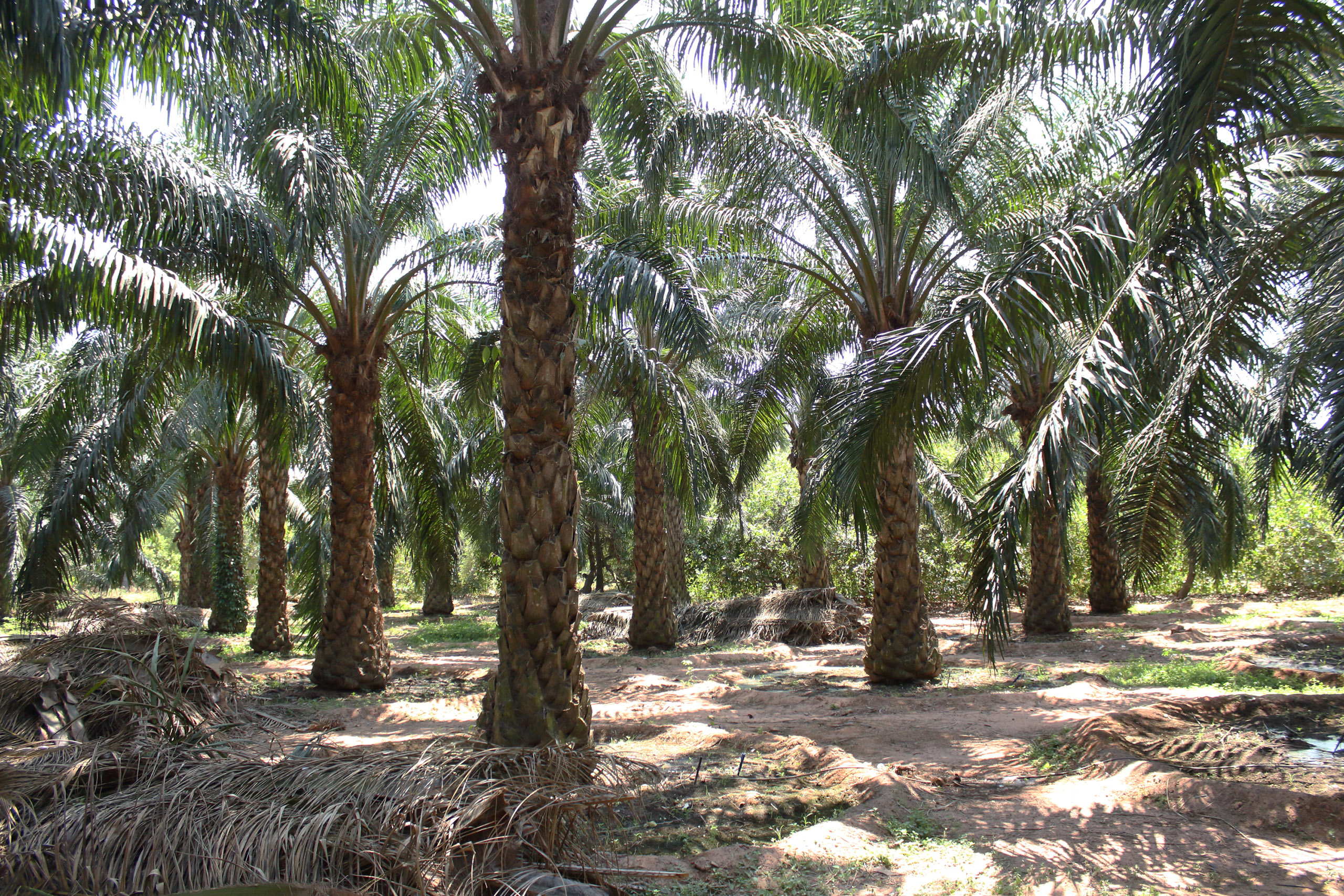
“In our area, water levels and rainfall have been good,” said Srinivas Prasad, chief executive and director of Navabharat Limited, miller and refiner of oil palm in West Godavari district. The company buys oil palm fruit from several areas including T. Narasapuram.
State information shows that of the 18 villages in T. Narasapuram for which data is available, groundwater is overexploited in six, critical in one, semi-critical in five, and safe in six. There is no data for four of the villages.
In Krishna district, assistant director of horticulture C.H. Sreenivasulu said that oil palm cultivation is increasing at about 1,000 hectares per year, despite depleting groundwater. The sub-district, or mandal, of Musunuru has 900-foot bore wells and oil palms aplenty, he noted. Of the 16 villages in this mandal, only two have safe groundwater levels. Groundwater is overexploited in eight, at a “critical” level in one and “semi-critical” in four. Data is unavailable for one village.
There are other problems. The rise in sea levels caused by climate change has made the aquifers along the coast increasingly saline. Seven of the oil-palm-growing districts in Andhra Pradesh are coastal. West Godavari has 53% of the province’s total area under cultivation, while East Godavari has 19%. Groundwater in 14 mandals in West Godavari, 10 in East Godavari and 13 in Krishna are fully or partially saline, according to a report from the Central Water Commission in 2017. The IIOPR (Indian Institute of Oil Palm Research) advises farmers not to grow oil palm using salty water.
The pesticide problem
Oil palm farmers also use banned pesticides. The IIOPR’s booklet specifies carbaryl for controlling rhinoceros beetles and methyl parathion or phosphamidon for mealy bug, despite these being banned by India’s Directorate of Plant Protection, Quarantine & Storage.
Many farmers control weeds with paraquat and glyphosate, both banned but available under different brand names. “We’ve been trying to get farmers to stop using them. Many have stopped,” said Srinivas Prasad. “In two or three years, everyone will stop.”
Weeds use up water and nutrients needed for the crop, which has prompted the IIOPR to advocate intercropping with other plants to prevent the growth of weeds and reduce the use of weedicides, said M. V. Prasad, senior scientist at IIOPR.

“I have not had weed problems since I planted cacao,” said farmer Subba Rao. “The large quantity of leaf litter from the cacao trees has improved the structure and organic content of the soil.” Besides cacao, the institute has identified and is experimenting with intercropping bush pepper and plants such as Heliconia psittacorum and Alpinia pupurata, whose flowers are sold for their beauty.
IIOPR has been forming farmer groups and providing chaff-cutter machines. “With the machine they can cut the fronds easily and spread them in the basin around each tree,” said M.V. Prasad. “It acts as mulch, conserving water and micro-organisms, as well as smothering the weeds.”
The practice of intercropping has not been embraced by all farmers because some have found it reduces yield. Madhava Rao, who grew climbers, found them getting damaged while harvesting the palm bunches. Another farmer who removed oil palms said that intercropping may solve weed problems, but requires more groundwater. An alternative way to tackle weeds has been to let cattle graze in plantations.
Marketing issues
The provincial government has divided the districts into agricultural zones, allotting them to 13 private and two government-owned oil palm mills. Farmers have a buy-back arrangement with the closest miller and are assured an income twice a month. But in Srikakulam district, one miller has shut down operations.
“Since there is no crushing unit and no transportation facility, many have uprooted palm trees and gone back to growing paddy,” said K. Ramana Reddy, founder-director of Society for Welfare Education and Environmental Protection, a non-governmental organisation. “Some who still have palms take the fruits to a factory in a neighbouring district. But some sell to middlemen at a lower price.”
Srinivas Prasad, whose company Navabharat is working towards Roundtable on Sustainable Palm Oil certification, pointed out that Andhra Pradesh has a robust mechanism on land use. Farmers are only converting existing farmland, he said. Navabharat is also working on the proper disposal of pesticide cans and documentation as part of the certification process.
Better water management
Farmers such as L. Rama Rao in West Godavari and K. Nagabushnam Rao in Krishna, who took to oil palm cultivation early, recall that water-intensive flood irrigation was the norm when they started. They have switched to drip irrigation over the last decade.

“Irrigating more will lead to leaching, leaving the root zone devoid of nutrients; irrigating less will lead to water-stress symptoms,” said Mathur. “We have developed a mobile app which uses analysis of 60 years of weather data to inform farmers how much water to use.”
The federal government advocates subsidies to help farmers install drip irrigation, but the Andhra Pradesh government stopped its subsidy in 2018. Reportedly it came to the conclusion that many farmers had moved over to drip systems already. Without subsidies, farmers like Nageswara Rao continue with flood irrigation.
Bujjibabu has sloped the ground and made a pit in which to dig his bore wells, so that there is more rainwater to recharge the aquifers where his bore wells are located. “Since I recharge, I get water at 160 feet, whereas others near me get it at 200 feet or more,” he said.
“These are one-off initiatives by farmers,” said Sreenivasulu. “All farmers should make similar efforts.” Some horticulture officials point out that water-resource management needs large-scale, long-term planning to improve the groundwater situation and safeguard the farming community.
Water scarcity affects all crops, not only oil palms, and has implications not just for farmers but whole communities living close to oil palm plantations.
This article was first published by China Dialogue, The Third Pole’s sister site
